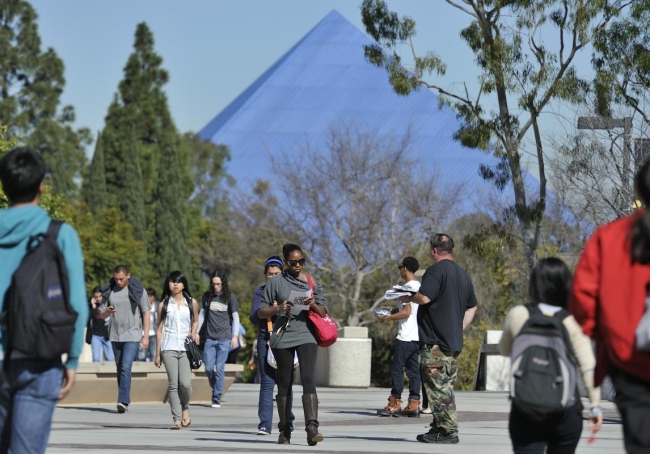You have /5 articles left.
Sign up for a free account or log in.

Cal State Long Beach is launching an ambitious plan to improve student mental health, which suffered during the COVID-19 pandemic.
MediaNews Group/Orange County Register/Getty Images
The COVID-19 pandemic only intensified Fidel Vasquez’s interest in mental health. A third-year student at California State University, Long Beach, Vasquez graduated high school in the spring of 2020 and started college—remotely—that fall.
“I wanted to be involved in mental health, in terms of just being a student during the pandemic,” Vasquez said. “I just didn’t feel like a university student, and I didn’t feel connected to my campus.”
Now Vasquez is playing a role in the university’s “mental health overhaul,” a new strategic plan titled “Healthy Living at the Beach” that includes more than 60 mental health initiatives to be implemented over the next three years.
Beth Lesen, vice president of student affairs and author of the plan, said each of the initiatives falls under one of five objectives: diversity and inclusion, building a community on and off campus, increasing awareness of mental health services, making mental health services more accessible, and using technology to reach students.
“It’s one of the largest, most ambitious and aggressive mental health initiatives I’ve found in higher education,” Lesen said. “In the beginning when I started putting this together and looking for models, I was really trying to find other campuses that were doing something on this scale so that I wouldn’t have to reinvent the wheel if someone else was doing something really impressive. And I didn’t find anything.”
Vasquez, a senator in the university’s student government, is part of a working group initiative set to launch next semester involving teams composed of an administrator and a student leader, plus either a mental health professional or a local community leader. Vasquez said leaders from other student organizations will also participate in the working groups.
Though the groups haven’t received their assignments yet, Vasquez expects his will focus on either improving the university’s counseling services or addressing the mental health needs of underserved communities on campus. The groups are slated to meet about twice a month, Vasquez said.
“I think the partnership that the university is doing right now with student government and campus leaders is a good sign,” Vasquez said. “And it’s a good indicator of how this initiative will hopefully be impactful. I think typically, when it comes to decision making, a lot of times students are left out in the dark, and they don’t know what goes on in those offices.”
Other action items include restructuring recruitment strategies to diversify the counseling center staff and creating more physical spaces on campus where students can feel comfortable sharing sensitive experiences.
The plan also aims to develop protocols to reach student identity groups and others impacted during national crises, as well as to establish community partnerships with local nonprofit organizations and resource centers.
Though the plan won’t be fully operational until 2025, Lesen said the university is already seeing results from pilot programs launched in the spring.
Among them: a text-based peer-to-peer mentor program offered last semester to 1,400 transfer students (out of a total enrollment of about 40,000 students), in which students reached out to peers during high-stress periods—such as midterms and finals—to check in.
According to data from Cal State Long Beach, the pilot featured 611 student connections and a response rate of 44 percent. The most frequently discussed topics were academic counseling and advising, financial aid and mental health counseling, and psychological services. Lesen said the texting service allowed transfer students to get answers to questions they might not have otherwise asked.
“These are people who did not choose to come forward and ask for help independently,” Lesen said. “But they were open to it when people came and found them. So that’s something we piloted where we had great success, and we’re expanding that pilot to all incoming students for the fall.”
In another pilot, the university launched a mobile crisis team composed of mental health practitioners to respond to psychiatric emergencies on campus. Typically college campuses require a campus police officer to respond in such cases, because they have the authority to initiate hospitalizations, Lesen said. But in the new Cal State Long Beach model, mental health professionals determined whether the student in distress needed to be hospitalized or simply referred for counseling.
“Any student would appreciate that, but particularly our communities of color really appreciate the idea of not having a psychiatric emergency responded to by a uniformed police officer,” Lesen said.
Associate vice president of health and wellness Damian Zavala, who oversees the mobile crisis team, wrote a grant proposal to the U.S. Substance Abuse and Mental Health Services Administration (SAMHSA) last year to get the program funded. In January, SAMHSA awarded the university $400,000 for the initiative.
“The thought behind it was that when our police department responds to crisis situations on campus with students or faculty or staff, they’re in uniform and they’re carrying a firearm,” Zavala said. “Even before a word is said, it just has a different optic. And so we wanted to create a team that could respond to those situations where trained clinicians come with a more trauma-informed, humanistic approach—not that the police can’t do that.”
Zavala said the mobile team is active now and is looking for additional staffing.
‘A Drop in Persistence’
Cal State Long Beach president Jane Close Conoley noted that even before the pandemic, the university was on track to add more counseling and mental health resources—but the pandemic underscored how urgent the need was.
“[During the pandemic] is the first time I’ve heard faculty talk about students just not showing up and not turning in assignments and feeling disengaged and alienated from their work,” Conoley said. “For the first time in my eight years, we had a drop in persistence. From first semester to second semester, we weren’t able to develop that sense of belonging. And without peer support and interaction, I think students—a larger number than typical for us—really just gave up and didn’t come back. So we can see that the pandemic really had effects on our students that really threaten their future.”
According to an enrollment survey of about 3,900 students in spring 2022, 2,069 said they were taking fewer than 15 credits to preserve their own well-being. For the upcoming fall semester, 1,328 students expect to take fewer than 15 credits.
Conoley said the most important part of Cal State Long Beach’s mental health plan is getting all 60-plus initiatives integrated and operational as soon as possible.
“I think certainly the biggest impact comes from getting all the pieces in place, and we will be working on this,” Conoley said. “There’s lots of programs all over the campus, but we haven’t tied them together. So that’s going to be a big deal when we understand that we have this clinic over here, and we have this program over here, and we try to pull it together.”




